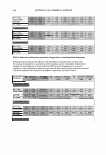336 JOURNAL OF COSMETIC SCIENCE 1 2 3 pH 8.9, Toward Cathode(-) 1 2 3 pH 8.9, Toward Anode(+) Figure 5. Estimation of pl for three collagens for cosmetic use from electrophoretic mobility at pH 8.9: (1) AteloHelogen®, (2) Collasol®, and (3) CLR Collagen®. DIFFERENTIAL SCANNING CALORIMETRY Various methods have been described for determining the thermal stability of collagens, where the change in a parameter is followed with increasing temperature. These include spectral methods, such as UV spectroscopy (25), ORD (20), and CD (21) enzyme digestion susceptibility (26), and calorimetric methods, such as differential scanning calorimetry (DSC) (27 ,28). The results obtained can depend on the method used. For example, even for any single method, different results may be obtained by changing the rate of heating. Also, the method used for calculating and reporting thermal stability is important. For example, most correctly report thermal stability as the midpoint of the thermal transition, as in the present report. However, others, typically measuring preparations with lower sta bility, may report the higher temperature at the end of the transition. Thus, thermal stability must be compared using defined standard conditions. In the present study we have examined the thermal stability of a range of collagens, including those available for cosmetic formulation, by a single method, DSC, using acetic acid as the solvent to ensure sample solubility. This method was chosen because it is generally readily available and has proven reproducibility. Data are reported using the generally accepted method of the midpoint of the thermal transition. All collagens gave distinct single endothermic transitions by DSC (Figure 6), with similar transition energies for comparable quantities of collagens. The thermal transi-
COLLAGEN EVALUATION Table II Amino Acid Analysis Results for Three Different Collagen Preparations Amino acid AteloHelogen® CLR Collagen® Collasol® HOPro 98 73 Asp 42 48 Thr 17 19 Ser 22 31 Glu 73 80 Pro 125 121 Gly 347 325 Ala 114 112 Cys n.d. n.d. Val 19 25 Met n.d. n.d. Ile 11 14 Leu 24 31 Tyr 1 7 Phe 13 16 His 4 6 HOLys n.d. n.d. Lys 28 31 Arg 54 55 Trp n.d. n.d. Data are expressed as residues per 1000. HOPro: 4-hydroxyproline. HOLys: hydroxylysine. Amino acids sensitive to oxidation (Met and Cys) were not determined. n.d.: not determined. 83 44 17 28 80 123 342 113 n.d. 26 n.d. 13 29 3 14 4 n.d. 26 50 n.d. 337 tions allowed the determination of Tm values (Table III). Replicate determinations were reproducible to 0.3°C or better. Significant variation in melting temperature was evident among the collagens from different species (Table III). Comparison of type I collagen Tm values shows that chicken collagen was the most stable at 44.7 ° C, about 2.5 ° C more stable than the mammalian samples, which had Tm values in a range between 42.0°C and 42.2°C. The fish collagens were considerably less stable (Table III), consistent with the previous observation that collagen stability approximates the upper environmental temperature experienced by an organism (8). Thus Macruronus lives in cold waters (29), giving it a lower environmental temperature than Tilapia, which lives in tropical regions where farmed fish may have environmental temperatures around 30°C (30). The Tilapia collagen, which has been suggested as suitable for cosmetic applications, gave a Tm of 35 .8°C (Table III). There is some variation of Tm with the pH of the samples, and so the pH of cosmetic collagen samples needs to be considered if the solutions are not made up in a standard solvent. The melting data show that for a given species, the type III collagen had a slightly greater Tm value, about l.2°C higher for mammals and 0.4°C higher for chickens, consistent with the stabilizing effects of a higher hydroxyproline content and the C terminal disulfide bonds that are present in type III collagen (1 7 ,31). Although purified chicken type I and type III collagens show a small difference in Tm (Table III), Atelo Helogen®, which contains a low level, about 7-10% of type III collagen (Figure 3, personal communication, Meddicoll), gave a single transition comparable to the purified chicken type I collagen, and a higher transition due to the type III component was not observed (Figure 6).
Purchased for the exclusive use of nofirst nolast (unknown) From: SCC Media Library & Resource Center (library.scconline.org)






































































































